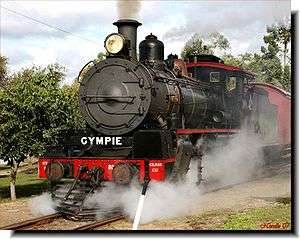Queensland C17 class locomotive
|
C17 No.802 Leaving Imbil to return to Gympie on the Mary Valley Rattler | |||||||||||||||||||||||
| |||||||||||||||||||||||
| |||||||||||||||||||||||
| |||||||||||||||||||||||
| |||||||||||||||||||||||
The C17 class engine is a 4-8-0 or likely a Mastodon type steam locomotive of the Queensland Railways.[1] These types of engines have operated on 1,067 mm (3 ft 6 in) narrow gauge.
The design was so successful that 227 locomotives were built from 1920 when the first engine N° 15 entering service through until 1953 when N° 1000 was delivered. The 22 NM class for Commonwealth Railways were of the same design. C 17s were versatile engines and generally well liked. They were used to haul Mail Trains on lines could not accommodate heavier (B18¼) classes, also suburban passenger, mixed, goods and branch line trains. Until 1948 they were the heaviest engines that could work north of Mackay. Prior to the introduction of 60 long tons (67 short tons; 61 t) diesel electric locomotives, they were responsible for hauling the air conditioned Inlander, Midlander and Westlander trains for parts of their respective journeys.
First engines had large steam domes, open cabs and C16 style tenders. Those built from 1938 onwards, commencing with N°858, had small steam domes, sedan cabs with welded tenders and also larger diameter (9 1⁄2 in or 241 mm) piston valves. The two types of boilers were occasionally interchanged at overhauls and by later years most of the old style ones had been replaced. The last 40 engines, N°961 to N°1000, were fitted with roller bearings and painted brown. They acquired the nickname of “Brown Bombers”. Those overhauled in the last years of steam operations were repainted black. A number of modifications were carried out over their life including the fitting of large mushroom air snifting valves. Several had additional sandboxes and/or rear headlights fitted at various times for working lines where no turning facilities were available.
Destination board
Queensland steam engines including the C17s were fitted with brackets in front of the smokebox where destination signs could be displayed.
Preservation
The C17s have survived strongly to the present day. Almost 30 examples still remain with eight currently operational or in near operational condition. Nos. 974 and 1000 are retained by the Queensland Rail Heritage Division. Two are currently interstate on the Zig Zag Railway at Lithgow, New South Wales. No. 934 has been operational there for some years, and No. 966 is awaiting restoration. No. 944 has been in open air storage at the Miles Historical Village and Museum in Miles, Queensland since 1971. No. 996 was placed on the waterfront at Southport on the Gold Coast, and was nicknamed "Southport Express". After calls by the local council to have the locomotive removed in 2005, it was purchased by the Queensland Pioneer Steam Railway, and is now at their Box Flat Depot in a dismantled state pending the decision to return it to operational condition. C17 720 (Walkers 348 of 1922) is operational at the Rosewood Railway Museum of the Australian Railway Historical Society Queensland Division. Locomotive 971 regularly pulls tourist trains in the Warwick, QLD area as part of the Southern Downs Steam Railway.[2]
Trivia
- The C17 engines are known as 4-6-0s or some Austrilian Mastodon type steam locomotives. These types of engines have twelve wheels (four driving wheels, eight driving wheels, and no trailing wheels) and were used most common on Australian railroads and have eight wheels on their tenders.
References
- "Queensland Railways C17 class". Queensland Railways Interest Group. Retrieved 2009-06-14.
- * Armstrong J ‘Locomotives of the Tropics Volume 2’ ISBN 0-909937-26-5
Footnotes
- ↑ "Archived copy". Archived from the original on December 26, 2008. Retrieved December 27, 2008.
- ↑ http://www.southerndownssteamrailway.com.au/assets_infrastructure/c17_971.php
External links
| Wikimedia Commons has media related to Queensland C17 class locomotives. |
